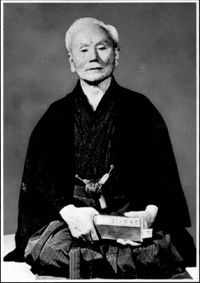 Gichin Funakoshi
Gichin Funakoshi
Gichin Funakoshi (Funakoshi Gichin, November 10, 1868 – April 26, 1957) was the creator of Shotokan karate and is attributed as being the "father of modern karate"[1]. Following in the teachings of Anko Asato and Anko Itosu, he was one of the Okinawan karate masters who introduced karate to the Japanese mainland in 1921.
Early Life
Gichin Funakoshi was born in Shuri, Okinawa in the year of the Meiji Restoration around 1868 and originally had the family name Tominakoshi. After entering primary school he became close friends with the son of Anko Azato, a karate and kendo master who would soon become his first karate teacher.
Stiff opposition of Funakoshi's family to the abolition of the Japanese "topknot" meant he would be ineligible to pursue his goal of attending medical school. Being trained in both classical Chinese and Japanese philosophies and teachings, Funakoshi became a assistant teacher in Okinawa. During this time, his relations with the Azato family grew and he began nightly travels to the Azato family residence to receive karate instruction from Anko Azato.
Funakoshi had trained in both of the popular styles of Okinawan karate of the time: Shorei-ryu and Shorin-ryu. His own style was influenced by kendo distancing and timing.
Shotokan is named after Funakoshi's pen name, Shoto, which means "pine waves" or "wind in the pines". In addition to being a karate master, Funakoshi was an avid poet and philosopher who would reportedly go for long walks in the forest where he would meditate and write his poetry.[4] Kan means training hall, or house, thus Shotokan referred to the "house of Shoto". This name was coined by Funakoshi's students when they posted a sign above the entrance of the hall at which Funakoshi taught reading "Shoto kan".
By the late 1910's, Funakoshi had many students, of which a few were deemed capable of passing on their master's teachings. Continuing his effort to garner wide-spread interest in Okinawan karate, Funakoshi ventured to mainland Japan in 1922.
The Creation of Shotokan Karate
In 1936, Funakoshi built the first Shotokan dojo in Tokyo. He changed the name of karate to mean "empty hand" instead of "China hand" (as referred to in Okinawa); the two words sound the same in Japanese, but are written differently. It was his belief that using the term for "Chinese" mislead people into thinking karate originated with Chinese boxing. Karate had borrowed many aspects from Chinese boxing which the original creators say as being positive, as they had done with other martial arts. In addition, Funakoshi argued in his autobiography that a philosophical evaluation of the use of "empty" seemed to fit as it implied a way which was not tethered to any other physical object.
Funakoshi's take on the use of kara was reported to have caused some recoil in Okinawa, prompting Funakoshi to remain in Tokyo indefinitely. His extended stay eventually led to the creation of the Japan Karate Association (JKA) in 1955 with Funakoshi as the chief instructor. Funakoshi was not supportive of all of the changes that the organization eventually made to his karate style. He remained in Tokyo until his death in 1957. After World War II, Funakoshi's surviving students formalized his teachings.
Legacy
Funakoshi published several books on karate including his autobiography, Karate-Do: My Way of Life. his legacy, however, rests in a document containing his philosophies of karate training now referred to as the niju kun, or "twenty principles". These rules are the premise of training for all Shotokan karateka and are published in a work titled The Twenty Guiding Principles of Karate Within this book, Funakoshi lays out 20 rules by which students of karate and urged to abide in an effort to "become better human beings."
